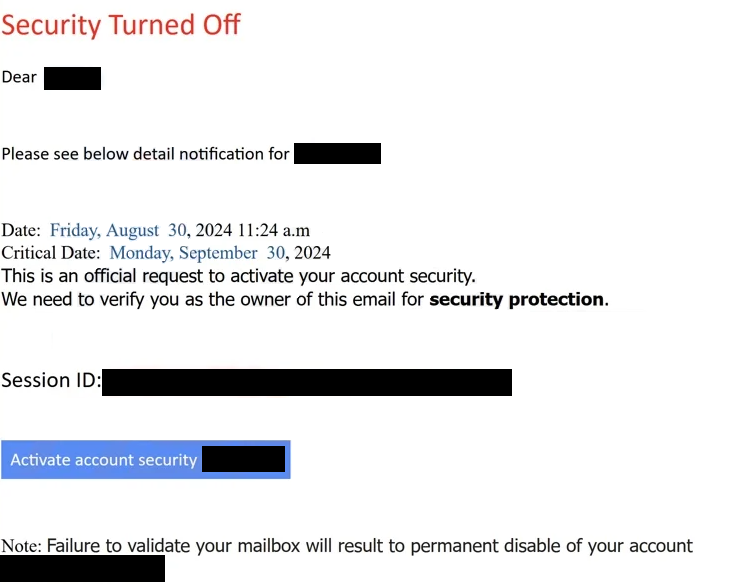The “Security Turned Off” email falls into the phishing email category. It aims to phish users’ email login credentials by claiming that users’ email accounts will be closed unless they verify that they are the owners of their accounts. If users engage with the email and click on the provided button, they will be taken to a phishing website where they’ll be asked to type in their email login credentials.

As far as phishing emails go, “Security Turned Off” is very typical and generic. Threatening to close an account unless users verify something is a classic way to get users to engage with the email.
The “Security Turned Off” email does not explain in detail what’s going on with the account, it only says that security for it has been turned off and that the email provider needs to verify that the recipient is indeed the owner of the account. If users do not validate their “mailbox”, their accounts will be supposedly closed.
The full contents of the “Security Turned Off” email are below:
Subject: Activate account security –
Security Turned Off
Dear –
Please see below detail notification for –
Date: Friday, August 30, 2024 11:24 a.m
Critical Date: Monday, September 30, 2024
This is an official request to activate your account security.
We need to verify you as the owner of this email for security protection.Session ID: –
Activate account security –
Note: Failure to validate your mailbox will result to permanent disable of your account –
Sincerely yours,
Online Helpdesk
Email TeamWe Manage Your Email Server so,You can focus on your business.
ServerToday
www.servertoday.com | support@servertoday.com | skype# servertoday
If you were to click on the “Activate account security” button, you would be taken to a phishing website. Depending on how sophisticated phishing attacks are, the phishing pages may look identical to the legitimate sites. The phishing site would ask that you enter your email account password because you’re been logged out. If you type in your password, it will be sent to the malicious actors operating this phishing campaign.
Email accounts are linked to many other accounts in a way that would allow malicious actors access to those accounts, which is why those credentials are in such high demand. Having your email account hijacked could have very serious consequences unless you notice in time to change your passwords and/or unlink your email address with your accounts. For example, malicious actors could gain control of your Facebook account and send messages impersonating you to your contacts asking for money.
Because email accounts are so important, you need to be extra careful with your credentials. It’s strongly recommended that you learn to recognize phishing emails.
How to recognize phishing emails
Regular users are usually targeted by low-effort and generic phishing emails. This means they should be easy to recognize. More sophisticated and convincing phishing emails usually only target specific people whose personal information the malicious actors have. But most users deal with generic ones.
How you are addressed by an email can help you identify whether it’s legitimate. This “Security Turned Off” email addresses you by your email username. Legitimate emails generally address users by name or rather the names users have given to the service provider. Words like “Customer”, “Member”, and “User” are usually signs of potentially malicious or spam emails.
Grammar and spelling mistakes are one of the most easily noticeable signs of a phishing email. They are very common in phishing emails, especially low-effort ones. Legitimate emails sent by legitimate companies will not have mistakes because they look very unprofessional. You would certainly not see mistakes in emails sent by email providers.
Phishing emails typically claim that there’s an issue with your account to force you to click on links. This applies to this “Security Turned Off” email as well. But generally, when you receive an email that asks you to do something, do not click on any provided links. If you believe the email to be legitimate and think there could be an issue with your account, simply log in manually instead of clicking on a link.
Finally, before you log in anywhere, make sure to check the URL of the site. No matter how similar phishing sites look to legitimate ones, the URL will never be the same. Malicious actors may use some tactic to make the URL seem more legitimate but as long as you pay attention and carefully check it, the differences should be noticeable.
“Security Turned Off” phishing email removal
If you get this email, you can just remove “Security Turned Off” from your inbox. If you have engaged with it by clicking on the button and typing in your login credentials, you need to change your email account password as soon as possible. If you cannot access your email account, contact the provider to see if you can get it back. If you cannot regain access, make sure to unlink the email address from all other accounts to prevent them from being hijacked as well.
Site Disclaimer
2-remove-virus.com is not sponsored, owned, affiliated, or linked to malware developers or distributors that are referenced in this article. The article does not promote or endorse any type of malware. We aim at providing useful information that will help computer users to detect and eliminate the unwanted malicious programs from their computers. This can be done manually by following the instructions presented in the article or automatically by implementing the suggested anti-malware tools.
The article is only meant to be used for educational purposes. If you follow the instructions given in the article, you agree to be contracted by the disclaimer. We do not guarantee that the artcile will present you with a solution that removes the malign threats completely. Malware changes constantly, which is why, in some cases, it may be difficult to clean the computer fully by using only the manual removal instructions.